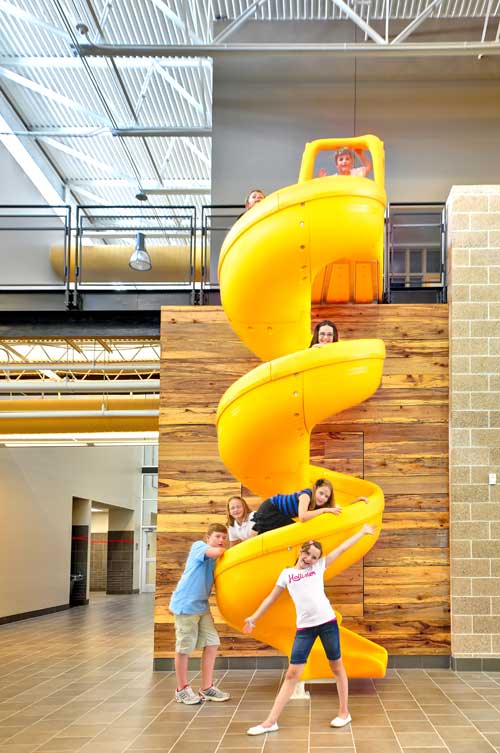March 3, 2013–January 5, 2014

Over 60 million Americans spend their days in K-12 school buildings. Ensuring that these students, faculty, and staff have a safe and healthy place to learn and work, and that the buildings conserve energy and water while remaining economical to build, are some of the most important issues facing educational leaders and city planners as they work to renovate older schools and build new structures.
Striving to provide the nation’s children with a healthy place to learn is not a new concept. As long as there have been school buildings, there have been advocates for architectural improvements to ensure that students had proper lighting, heating, and fresh air. But with the real problems of overcrowding, age, and budget crises, many green visions have fallen short. The Government Accountability Office (GAO) has estimated that 25,000 school buildings now in use are in need of extensive repair or replacement, and that thousands of these schools are circulating air that is unsafe to breathe.
The good news is that we know a lot about the environments in which students learn better—where they have access to natural light and fresh air and limited exposure to harmful chemicals. School systems can now procure a wide variety of safe cleaning products and affordable recycled building products. Administrators and teachers know that resources are available to incorporate sustainability into all aspects of the curriculum. Studies have shown that with the implementation of certain principles of green schools, fewer days are lost due to illness, money is saved, and test scores go up.
So, what are we waiting for? Not all sustainable solutions are easily implemented or clearly desired by everybody. Some parents complain when asked to send only reusable sandwich bags. Others prefer that the curriculum be kept to the traditional subjects, without spending time teaching students about compost and gardening. And state and local governments can balk at the additional costs involved, even with promises that funds will be recouped later with savings in energy costs. Building 100,000 net-zero public schools across the country is an improbable goal, but there are many things each of us can do—whether parents, students, school staff, or community members—to green our schools.
This exhibition will look at several examples of what is possible—at the future that, in some places, is already here—and provide resources for all of us to consider as we look toward constructing the next generation of school buildings. Featured will be an actual green classroom, Sprout Space developed by the architectural firm Perkins+Will. Visitors will have the chance to walk through the classroom and see the green features in action. Within the exhibition, visitors will see photographs, touch samples, and hear from those who have made their green dreams into reality.
Sponsors
Related Content
Cleaning Up the Cleaning Industry: A Green Schools Highlight
Green Schools is generously sponsored by Perkins+Will; Triumph Modular; Whole Foods Market; Satellite Shelters, Inc.; The Tower Companies; Forbo Flooring Systems; The Kendeda Fund; Multivista Construction Documentation; Interface, Inc.; McGraw-Hill Construction; Nixon Peabody LLP; The Sherwin-Williams Company; Gilbane Building Company; Perkins Eastman; Modular Building Institute; Waterless Co.; Hord Coplan Macht; Kramer Consulting Services, PC; and Quinn Evans Architects. McGraw-Hill Construction is the official media partner of Green Schools.
Generous in-kind contributions to the exhibition have been provided by Modular Air, Inc; Mark Line Industries, Inc.; School Specialty, Inc.; Multivista Construction Documentation; Bison Innovative Products; Kawneer Company, Inc.; Modular Genius, Inc.; MooreCo, Inc. DBA Best-Rite and Balt; AGC Flat Glass North America; Hord Coplan Macht; LG Electronics USA, Inc.; Forbo Flooring Systems; Acuity Brands, Inc; Bretford; Smith Systems™; Riverbend Nursery, Inc.; TOTO USA; The Sherwin-Williams Company; Interface, Inc.; SAGE Electrochromics, Inc.; Diversified Educational Systems Inc.; Waterless Co.; Excel Dryer, Inc.; Advanced Solar Technologies; and Solatube International, Inc.
